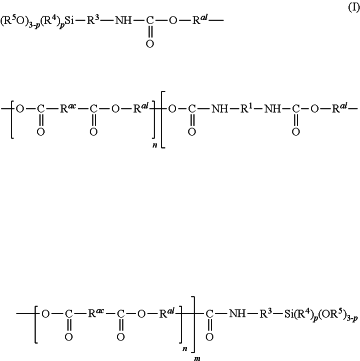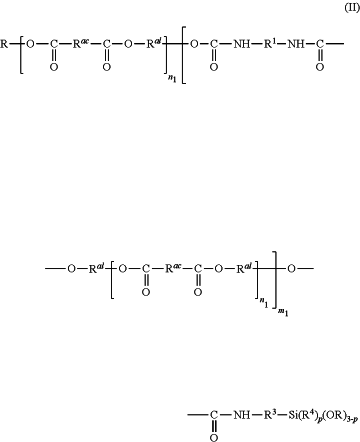| CPC C09J 7/35 (2018.01) [C08G 18/755 (2013.01); C08G 18/7621 (2013.01); C08G 77/458 (2013.01); C08L 75/06 (2013.01); C09J 175/04 (2013.01); C08G 2170/40 (2013.01); C08L 2201/10 (2013.01); C08L 2205/025 (2013.01); C08L 2205/03 (2013.01); C08L 2312/00 (2013.01); C09J 2301/122 (2020.08); C09J 2475/00 (2013.01)] | 20 Claims |
|
1. A heat-crosslinkable adhesive composition, comprising:
from 20% to 84% by weight of a composition (A) comprising:
from 75% to 100% by weight of at least one polyurethane comprising two end groups of alkoxysilane type which are hydrolyzable and having the following formula (I):
 wherein:
R1 represents a divalent hydrocarbon radical comprising from 5 to 15 carbon atoms which can be aromatic or aliphatic and linear, branched or cyclic;
Ral represents a divalent hydrocarbon radical resulting from a saturated diol, by replacement of each of the two hydroxyl groups by a free valency, said diol having a hydroxyl number IOH of greater than 220 mg KOH/g;
Rac represents a divalent hydrocarbon radical resulting from a saturated dicarboxylic acid, by replacement of each of the two carboxyl —COOH groups by a free valency, said acid having an acid number IA of greater than 200 mg KOH/g;
n is a number such that the polyester diol of formula (III):
 has a hydroxyl number IOH of between 4 and 24 mg KOH/g;
Ra1 represents a linear divalent alkylene radical comprising from 1 to 3 carbon atoms;
Rac, which are identical or different, each represent a linear or branched alkyl radical of 1 to 4 carbon atoms, with the possibility, when there are several Rac radicals, that the latter are identical or different;
m is an integer such that the number-average molar mass of the polymer of formula (I) is between 400 g/mol and 50 000 g/mol;
p is an integer equal to 0, 1 or 2;
from 0% to 25% by weight of at least one polyurethane comprising one end group of alkoxysilane type which is hydrolyzable and having the following formula (II):
 wherein:
n1 and m1 are each integers such that the number-average molar mass of the polyurethane of formula (II) is between 400 g/mol and 50 000 g/mol;
Rac and Ral are as defined above; and
R represents a monovalent hydrocarbon radical resulting from a monol, by replacement of the hydroxyl group by a free valency;
said composition (A) being obtained by a process which comprises a stage of preparation of a composition (A-1) comprising an amorphous polyester diol of abovementioned formula (III) or a mixture of amorphous polyester diols of abovementioned formula (III), by reacting, by a polycondensation reaction:
(i) a composition (A-1-1) comprising at least one saturated dicarboxylic acid, said composition (A-1-1) having an acid number IA of greater than 200 mg KOH/g; and
(ii) a composition (A-1-2) comprising at least one saturated diol, said composition (A-1-2) having a hydroxyl number IOH of greater than 220 mg KOH/g; and
(iii) optionally a composition (A-1-3) comprising at least one monol;
provided that at least one saturated dicarboxylic acid of the composition (A-1-1) or at least one saturated diol of the composition (A-1-2) is branched;
the composition (A-1) having a hydroxyl number IOH of between 4 and 24 mg KOH/g;
from 15% to 79% by weight of a compatible tackifying resin (B), with a number-average molar mass of between 200 g/mol and 50 000 g/mol; and
from 0.01% to 5% by weight, of a crosslinking catalyst (C).
|